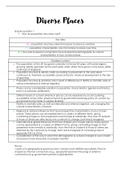Summary
Summary Diverse places revision notes for A Level Edexcel Geography
- Module
- Diverse places
- Institution
- PEARSON (PEARSON)
Very detailed revision notes for Diverse places topic in A Level Edexcel Geography. Case studies may differ in my notes than to the ones studied in class but the rest of the information remains the same as I have included absolutely everything from the specification, therefore only need to switch t...
[Show more]



